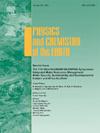Seismic attributes and spectral waveform-constrained porosity-controlled dynamical simulations of lower-Cretaceous shale gas-bearing Lowstands prograding wedges and deep-water submarine fans, NE-Indus rifting delta
IF 4.1
3区 地球科学
Q2 GEOSCIENCES, MULTIDISCIPLINARY
引用次数: 0
Abstract
Quantitative seismic reservoir simulations are an accurate estimation tool for quantitative imaging of lowstand prograding wedge systems (LPW) of deep-water shale gas-bearing submarine fans. These LPWs are filled with coarse-grained sandstone lenses deposited during a significant sea-level fall, followed by a minimal rise. The key implication for imaging these LPWs is whether the shelf-break was developed. These are the key concerns that decide whether the shale gas systems are developed at the inner shelf edge or outer shelf-edge deltaic systems. During the development of stratigraphic traps, the sea level has a strong influence on the facies migrations and depositions. Additionally, the Indus Delta is dominated by the divergent plate margins. Therefore, there must be normal fault systems. These normal fault systems have played their role either in providing the lateral seals or the migration pathways for exploration of LPWs from this zone. Hence, the exploration becomes very ambiguous due to the influence of sea level and tectonics. Therefore, poor frequency-controlled sub-seismic data are constrained to quantify the LPW's reservoir rock types, thicknesses, location, inclination of LPW, fluid dynamics impedances contrasts (IDS) of low-frequency anomalies of hydrocarbon-bearing sandstones, and stratigraphic pinch-out zones. This research utilizes spectral attributes consortium and spectral waveform-constrained porosity-controlled quantitative dynamical simulations (PHVAS) on a gas field, NE-Indus Onshore. The 28-Hz envelope sub-bands-based (28-ESB) horizon slice have imaged 13 m thick and coarse-grained sandstones-bearing LPW at amplitude mapping, but failed to predict the inclined surfaces of LPW from the mid-to-upper slope geomorphology. Conventional PHVAS simulations with an R2 < 0.70 produced LPW thicknesses of 20–44 m and impedance values of −0.883 gm./cc∗m/s, but remained poor in resolving the top sealing layer. 28-ESB PHVAS shows R2 > 0.95 at seismic-based porosity [SBP] [%] of 25–30 %, images 42-48-m thick [STS] for organically-rich shale-plugged LPW at <2° inclination and highest sedimentary influx at −0.303gm./cc.∗m/s [SIS]. Western zones at 28-ESB experience −0.28 and −0.303gm./cc.∗m/s SIS and 28-Hz low-frequency anomaly below LPW, implicating regionally developed hydrocarbon-bearing progradational-to-aggradational sedimentary traps along horizontally-fluctuating SIS during fall-to-standstill sea-level. Eastern zones at 28-ESB PHVAS experience −0.2 and −0.169-gm/c.c.∗m/s SIS, 8-10-m STS lateral transgressive seal at 5–10 % SBP, which are inclined at >5°, implicating rising sea-level and stratigraphic pinch-out. PHVAS has also predicted no-fault and shelf-break exposure along this shale gas system. This indicates that the LPW was developed in the upper slope zones of LPW. This implies that the vertical and lateral migrations were categorically controlled by the vertical and lateral changes in the rock type within the stratigraphy of LPW. Consequently, this workflow serves as an analogue for exploring global basins.

NE-Indus裂谷三角洲下白垩统低洼洼推进楔和深水海底扇含气地震属性和频谱波形约束孔隙度控制动力学模拟
地震储层定量模拟是深水含页岩气海底扇低水位推进楔体系统定量成像的准确估计工具。这些LPWs充满了在海平面显著下降期间沉积的粗粒砂岩透镜体,随后是最小的上升。对这些LPWs进行成像的关键意义在于是否形成了大陆架断裂。这些是决定页岩气系统是在陆架内缘还是陆架外缘三角洲系统开发的关键问题。在地层圈闭发育过程中,海平面对相运移和沉积有很强的影响。此外,印度河三角洲以扩张的板块边缘为主。因此,必须存在正常的故障系统。这些正断层系统为该区油气勘探提供了侧向封闭或运移通道。因此,由于海平面和构造的影响,勘探变得非常模糊。因此,较差的频率控制次地震数据限制了对低波储层岩石类型、厚度、位置、低波储层倾角、含油气砂岩低频异常的流体动力学阻抗对比(IDS)和地层尖灭带的量化。该研究利用了光谱属性联盟和频谱波形约束孔隙度控制定量动力学模拟(PHVAS),对东北印度河沿岸的一个气田进行了研究。基于28-Hz包络子带(28-ESB)的水平切片在幅值填图上可以成像13 m厚、粗粒砂岩的低砾石路面,但无法从中上坡地貌预测低砾石路面的斜面。R2 <的传统PHVAS模拟;0.70产生的LPW厚度为20 ~ 44 m,阻抗值为−0.883 gm./cc∗m/s,但在解析上封层时仍然较差。28-ESB PHVAS显示R2 >;在25 - 30%的地震孔隙度[SBP] [%], 42-48 m厚的图像[STS],倾角为<;2°,最高沉积流入量为- 0.303 mg ./cc。∗m / s (SIS)。西部地区在28-ESB经历- 0.28和- 0.303毫克/立方厘米。(* m/s) SIS和低水位以下的28 hz低频异常,暗示在海平面下降至静止期间,沿水平波动的SIS区域发育了含油气的进积-沉积圈闭。东部地区28-ESB PHVAS经历- 0.2和- 0.169 gm/c.c。* m/s SIS, 5 ~ 10% SBP处8 ~ 10 m STS侧向海侵封盖,倾角为>;5°,暗示海平面上升和地层尖出。PHVAS还预测了沿页岩气系统的无断层和大陆架断裂暴露。说明低洼区主要发育在低洼区上坡带。这表明,垂向和侧向运移是由LPW地层内岩石类型的垂向和侧向变化所控制的。因此,该工作流程可以作为勘探全球盆地的模拟方法。
本文章由计算机程序翻译,如有差异,请以英文原文为准。
求助全文
约1分钟内获得全文
求助全文
来源期刊

Physics and Chemistry of the Earth
地学-地球科学综合
CiteScore
5.40
自引率
2.70%
发文量
176
审稿时长
31.6 weeks
期刊介绍:
Physics and Chemistry of the Earth is an international interdisciplinary journal for the rapid publication of collections of refereed communications in separate thematic issues, either stemming from scientific meetings, or, especially compiled for the occasion. There is no restriction on the length of articles published in the journal. Physics and Chemistry of the Earth incorporates the separate Parts A, B and C which existed until the end of 2001.
Please note: the Editors are unable to consider submissions that are not invited or linked to a thematic issue. Please do not submit unsolicited papers.
The journal covers the following subject areas:
-Solid Earth and Geodesy:
(geology, geochemistry, tectonophysics, seismology, volcanology, palaeomagnetism and rock magnetism, electromagnetism and potential fields, marine and environmental geosciences as well as geodesy).
-Hydrology, Oceans and Atmosphere:
(hydrology and water resources research, engineering and management, oceanography and oceanic chemistry, shelf, sea, lake and river sciences, meteorology and atmospheric sciences incl. chemistry as well as climatology and glaciology).
-Solar-Terrestrial and Planetary Science:
(solar, heliospheric and solar-planetary sciences, geology, geophysics and atmospheric sciences of planets, satellites and small bodies as well as cosmochemistry and exobiology).
 求助内容:
求助内容: 应助结果提醒方式:
应助结果提醒方式:


